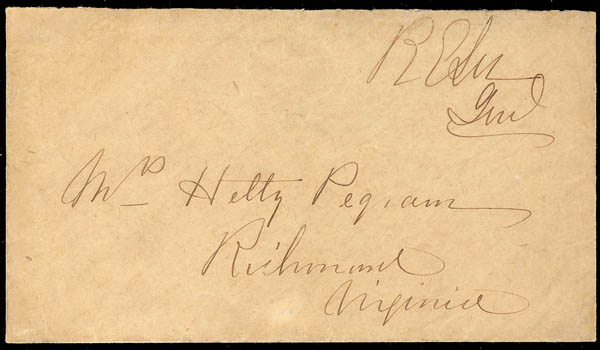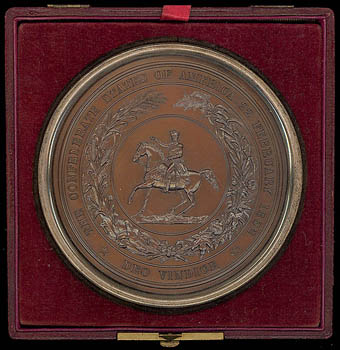
Lot
2499 
Confederacy, Robert E. Lee, bold endorsement "R. E. Lee Genl" on field cover addressed in his hand to "Mrs Hetty Pegram, Richmond, Virginia", small cover tear at top, included is a photocopy of the enclosure written in Lee's hand datelined "Petersburg (Va.) 11 Feb, 65" to the widow of General Pegram expressing his condolence over Pegram's death, which is now housed in the collection of the Virginia Historical Society, Extremely Fine; with 1967 G.T. Banks letter of signature attest. Estimate $10,000 - 15,000.
A REMARKABLY CHOICE ROBERT E. LEE FIELD COVER ADDRESSED TO GENERAL PEGRAM'S WIDOW.
On January 19, 1865, Pegram married Hetty Cary in a well-attended ceremony in St. Paul's Church in Richmond. Among the celebrants was Confederate President Jefferson Davis and his wife, Varina. Less than three weeks later, Pegram was killed in action during the Battle of Hatcher's Run on February 6, 1865.
Realized: $9,500

Lot 2500
Confederacy, Great Seal of the Confederacy, 1873 electrotype in copper made from the original silver seal, 3½'' in diameter, featuring George Washington in the center (modeled after an equestrian statue in Richmond), surrounded by a wreath of Confederate products (wheat, cotton, tobacco, corn, sugar and rice) and text "THE CONFEDERATE STATES OF AMERICA : 22 FEBRUARY 1862" and "DEO VINDICE" around the exterior, set in a glass topped frame within original red leather case with felt lining, in the case (below the seal) is a enamel card signed by James M. Mason who was the Confederate commissioner to England and ordered the seal to be made, Very Fine, a wonderful example of this iconic Confederate State Seal.Estimate $5,000 - 7,500.
Ordered by the Confederacy to serve as both a means to emboss documents and to lend themselves credibility as a government, the original Great Seal of the Confederacy was engraved in England by Joseph S. Wyon (Queen Victoria's chief engraver), and smuggled in-country via Bermuda circa 1864. As the embossing machine never left Bermuda, the Seal saw little use, and was eventually smuggled out of Richmond by one William Bromwell, disbursing clerk with the Confederate State Department, along with the contents of the State Department Archives. Nearly a decade later, in 1872, Bromwell, by way of John T. Pickett, former Confederate Commissioner to Mexico, arranged for the sale of the Confederate Archive to the U.S. Government. At the close of the deal, Pickett gave the Seal as a gift to Lieutenant (later Admiral) Thomas O. Selfridge, USN, the Government representative for the deal. It is believed a year later, Pickett, on unknown pretenses, borrowed the seal from Selfridge and took it to one Samuel H. Black of New York. Operating under a Masonic Oath to not reveal his involvement, Black produced a series of electrotype copies in gold, silver and bronze directly from the original seal. Pickett returned the original to Selfridge, and made a brisk business of selling the copies.The original seal eventually made its way into the Museum of the Confederacy in Richmond, where it can be seen today.
